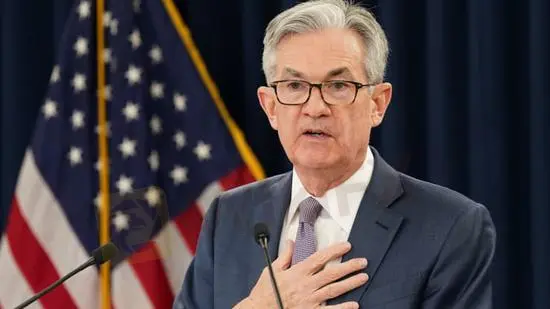简体中文
繁體中文
English
Pусский
日本語
ภาษาไทย
Tiếng Việt
Bahasa Indonesia
Español
हिन्दी
Filippiiniläinen
Français
Deutsch
Português
Türkçe
한국어
العربية
Fed may pause policy tightening in September
Abstract:The Federal Reserve could pause its monetary policy tightening in September if there is an economic deterioration and inflation subsides
The Federal Reserve could pause its monetary policy tightening in September if there is an economic deterioration and inflation subsides, BofA strategists said on Thursday, a day after the U.S. central bank released the minutes from its May policy meeting.

All of the Fed's policymakers agreed to hike interest rates by half a percentage point at the May 3-4 policy meeting to counter rampant inflation and most participants said further hikes of that magnitude in June and July could be appropriate.
But the minutes also showed the Fed grappling with how best to reduce inflation without causing a recession or pushing the unemployment rate substantially higher - a task that several participants said would prove challenging.
The central bank would likely pause its tightening in September, leaving its benchmark overnight interest rate in a range of 1.75% to 2% if financial conditions worsened, BofA strategists said in a note.
“We have recently seen a tenuous but remarkable change in Fed communications, where some Fed officials suggest the option of downshifting or pausing later in the year as they reach 2% given the challenging macro backdrop, tightening of financial conditions, and potentially softening inflation,” they said.
Inflation, by the Fed's preferred measure, is currently running at more than three times the central bank's 2% target.
Fed funds futures traders on Thursday were pricing in 50-basis-point rate hikes at each of the central bank's June and July meetings and another 25-basis-point hike in September.
While noting that it was not its base case scenario, BofA said the central bank may see a federal funds rate at 1.75%-2% as providing “a normalization of policy which then offers an opportunity to pause and assess the impact on jobs and inflation.”
A pause in tightening could lead to lower rates across the U.S. Treasury yield curve, the strategists said.
The benchmark 10-year U.S. government bond yield hit its lowest level since April on Thursday. It has fallen from 3.2% on May 9, as the bond market sees the economy slowing and expects inflation to lose momentum.
Other analysts, however, do not see the Fed as having shifted to a more dovish stance.
Strategists at TD Securities said they expected the central bank to hike rates above the neutral rate, the level which neither stimulates nor constricts economic growth, but at a more gradual pace after the June and July policy meetings. Fed policymakers estimate the neutral rate to be roughly between 2% and 3%.
“The views expressed in the minutes are about all they could say at the start of an aggressive tightening cycle where no one really knows how far rates have to go,” investment bank Brown Brothers Harriman said in a note.
“The Fed is facing a very complicated situation and so is trying to burnish its hawkish credentials while trying not to pre-commit to any rate path”, it said.
Disclaimer:
The views in this article only represent the author's personal views, and do not constitute investment advice on this platform. This platform does not guarantee the accuracy, completeness and timeliness of the information in the article, and will not be liable for any loss caused by the use of or reliance on the information in the article.
Read more

FED meeting minutes strongly hint at a rate cut in September; US dollar index falls to new low this year!
The U.S. Bureau of Labor Statistics revised down the employment growth in the year ending in March by 818,000, an average monthly decrease of about 68,000, the largest downward revision since 2009. The substantial downward revision of employment data re-emphasized the severity and necessity of the U.S. employment problem, paving the way for a rate hike in September. Bearish for the U.S. dollar.

Gold Price Tops $2500 For the First Time
Gold prices soared above the $2,500 mark for the first time, driven by expectations of potential interest rate cuts, which have weakened the dollar to its recent low levels. Market participants are now focused on Wednesday’s FOMC meeting minutes for insights into the Fed’s next monetary policy moves.

What new signals does the Federal Reserve have? FED Governor Michelle Bowman reiterates the risk of inflation!
Fed Governor Bowman: There are upside risks to inflation, the labor market continues to strengthen, and a cautious attitude will be maintained at the September meeting. Boston Fed President Collins: If the data is as expected, it would be appropriate to start easing policy "soon". Inflationary pressure will slow down the pace of U.S. interest rate cuts, which will be bullish for the dollar.

GEMFOREX - weekly analysis
The week ahead – Top 5 things to watch
WikiFX Broker
Latest News
Geopolitical Events: What They Are & Their Impact?
Volkswagen agrees deal to avoid Germany plant closures
Top 10 Trading Indicators Every Forex Trader Should Know
WikiEXPO Global Expert Interview: Simone Martin—— Exploring Financial Regulation Change
TradingView Launches Liquidity Analysis Tool DEX Screener
MultiBank Group Wins Big at Traders Fair Hong Kong 2024
'Young investors make investment decisions impulsively to keep up with current trends' FCA Reveals
Why Do You Feel Scared During Trade Execution?
CySEC Settles Compliance Case with Fxview Operator Charlgate Ltd
Malaysian Influencer Detained in Taiwan Over Alleged Role in Fraud Scheme
Currency Calculator


